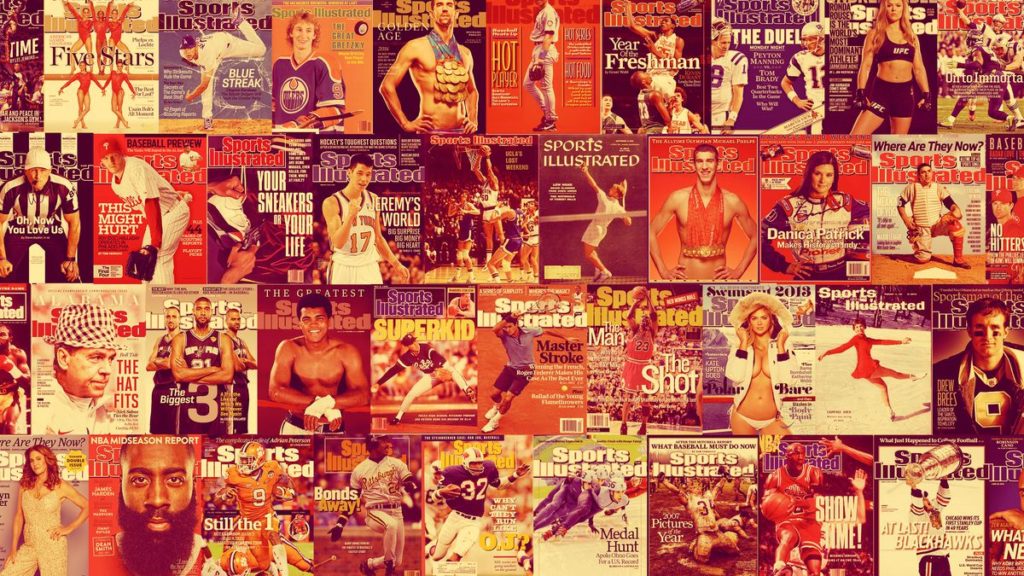ESPN the Magazine Dead; Sports Illustrated Dying
A depressing day in the world of sports journalism.

Sports Illustrated was long one of my favorite magazines. Because it could pay top dollar, it attracted not only the best sportswriters from around the country but many of the best writers, period. Established in 1954, well before I was born, it has always been around from my perspective.
ESPN The Magazine was a comparative upstart. Because it debuted when I was in my 30s, it seems like it has been around much less than its twenty years. I’ve subscribed to it since nearly its inception, but only because it came packaged with the old ESPN Insider package that unlocked premium content on ESPN.com.
Over time, the two became indistinguishable and, frankly, often went unread. It wasn’t obvious why I needed a weekly print sports magazine in the age of the Internet. Indeed, they seemed to rely too much on non-sports gimmicks like the infamous SI swimsuit issue and ESPN’s Body Issue knock-off.
Both, it appears, are going the way of the dodo bird.
One, for sure.
John Ourand of Sports Business Daily:
ESPN is ending the print version of ESPN the Magazine in September, more than 21 years after its launch. The news of the print magazine’s demise was announced to staff this morning as part of a reorganization of Senior VP/Original Content Rob King‘s department. ESPN says that the move will not involve any layoffs today, though it is likely that a handful of print/publishing/circulation employees — said to be in the single digits — will be without jobs come September. An ESPN spokesperson said the company already had integrated the magazine’s employees across its platforms.
In an emailed statement, ESPN said, “Consumer habits are evolving rapidly, and this requires ESPN to evolve as well. The only change here is that we are moving away from printing it on paper and sending it in the mail. … Our data shows the vast majority of readers already consume our print journalism on digital platforms, and this approach will maximize our reach and impact.” ESPN said it will consider publishing print versions of special issues — like the Body Issue — in the future. The magazine launched in March ’98. Sources said that it has lost money for the past several years. “It was not close to a break even proposition,” a source said.
— “ESPN The Magazine To Cease Publishing In September“
The other is certainly on the ropes. Jean E. Palmieri in, of all places, Women’s Wear Daily:
If Authentic Brands Group is successful in snapping up Sports Illustrated, it would undoubtedly become primarily a licensing and digital play.
According to sources, the print magazine would continue to be published for at least the next two years as ABG works to capitalize on its content to extend the brand’s reach into a number of sports-related businesses. That could include everything from camps for kids to sports rehabilitation clinics, sources said.AGB owns 50 brands, 45 percent of which are in the fashion space, and is the world’s fourth-largest licensing company. It has $9.3 billion in annual retail sales. Among its sports-affiliated brands are Greg Norman, Shaquille O’Neal, Muhammad Ali, Prince, Spyder, Volcom, Hind, Above the Rim and Julius Erving.
One source close to the company said a Sports Illustrated site could potentially include golf tips from Norman or basketball strategy ideas from O’Neal. “This would be very different from just making Sports Illustrated jackets,” the source said. “That’s not the business they’re going into.”[…]
Sports Illustrated had been one of the flagship titles for Time Inc. but Meredith, which purchased Time Inc. for $1.85 billion in 2018, said immediately that it did not fit into company’s lifestyle magazine portfolio and would be put up for sale along with Time Magazine, Fortune and Money.
Meredith sold Time Magazine to Salesforce’s Marc and Lynne Benioff for $190 million, and Fortune to Thai businessman Chatchaval Jiaravanon for $150 million. Last week it abandoned efforts to sell Money, saying it would retain the title but convert it to a digital-only product starting this summer.
Meredith had originally hoped to sell Sports Illustrated for around $150 million, but the price has now gone down as potential acquirers balked at such a high ticket.
— “ABG’s Plan for Sports Illustrated Would Be Licensing Focused“
That doesn’t exactly sound like a bright future for SI.
It’s sad to see venerable brands die off but it happens all the time. Indeed, SI’s companions, Time and Life, were both bigger properties once upon a time. Life is long defunct and Time seemingly exists to cater to geriatrics and dentists’ offices.





James, I’m not sure what you are mourning here. Is it that the paper magazine is dying? Or do you think that ESPN and Sports Illustrated aren’t viable even in an on-line world?
@MarkedMan: Just the dying off of venerable brands, notably SI. ESPN The Magazine always seemed somewhat superfluous, since the content was all available on the DOTCOM. SI was always a magazine first and did Web as an afterthought. Indeed, it was forever CNN-SI or some such.
@James Joyner: I’m not getting from the expert you posted above that SI is dying, only that I probably won’t continue indefinitely as a paper magazine and that they didn’t get their initial asking price. It seems like quite a leap to assume they will cease to exist.
Dr. Joyner –
Although I never subscribed to ESPN the magazine, I did read SI religiously at a kid. Literally every week. But truth is I haven’t read it in probably 15 years except when waiting in my Doctor’s or Dentist’s offices. I log onto ESPN daily, but SI’s website has ALWAYS been sub par so it rarely got clicks from me.
What your feeling is what I felt with the Los Angeles Herald Examiner ceased to exist. It was the newspaper I grew up reading daily. When it stopped publishing in in 1989 it felt like I was losing a something important in my life. But soon the internet came along and…
@MarkedMan:
Oh, it will cease to exist alright. There just isn’t that big an appetite for long form journalism, for sports or any other world. No one wants to read 10,000 words on something that happened last week when they can read 2,000 words on what happened yesterday.
@EddieInCA:
Yes, I think this is right.
With SI, I’ve been for years in the same boat Steven Taylor described when we last had this discussion: I tended to subscribe when the price is lower enough and/or the throw-in sweet enough. So, it’s not like it continues to play a major role in my media consumption anymore. But I hold it more fondly in my memory than, say, CBS Nightly News, which I ceased watching when Walter Cronkite left.
@EddieinCA: I don’t know how big the market for long-form journalism is, but the dozen-or-so issues of Vanity Fair and The New Yorker that are sitting on the floor next to my couch here confirm that there is some market.
@MarkedMan: Not only do I agree with @EddieinCA that the business model of sports- (and news-) weeklies simply doesn’t make sense in the Internet age, it very much sounds like SI is being bought for its trademarks and licensing rights. I don’t see what an apparel brand gets from continuing to put out a money-losing mag.
Back in the late 80s through the early years of this century, my brother had a subscription to SI which arrived at work. We also had subscriptions to TIME and Newsweek. I read SI sometimes out of boredom during light work periods (this was before the Internet was available at work and/or dial-up era; I think we got broadband until 1998 or so).
It was good, if you were interested in the subject. Past reading about Football, though, I generally wasn’t. though the issues covering the Winter Olympics every four years were quite interesting as well.
When I switched jobs in 2004, I missed TIME and Newsweek a lot.
@Teve: Some doctors offices keep magazines around, usually way put of date. Some of the local schools sell magazine subscriptions as fundraisers.
No one around here has newspaper delivery and most of the stores don’t have the coin boxes.
My favorite SI article was the Ted Williams fishing trip.
@James Joyner: Wait, Sports Illustrated has a clothing line?
Okay, I guess that means I’m so out of touch I have nothing to contribute to this conversation.
Wait. The same marketing geniuses who thought it was a good idea to but a hijab and “burkini” clad model in the swimsuit issue have frittered away the franchise as their environment changed?
Well I’ll be dam……..
There is little purpose to print physical versions SI or ESPN The Magazine.
It is an anticipated and inevitable cultural change. It is a sign of an era change.
@Guarneri:
Ain’t you a little snowflake?
Yeah, that was the straw that broke the camel’s back – the non-patronizing inclusivity was the breaking point. Keep telling yourself that. That’ll get you far.
@James Joyner: I gave up on them a while back–even though the subscription rate was quite low. The move to cheaper paper a while back, which dulled the photos, struck me as harbinger of death some time ago.
@Steven L. Taylor: It’s been a couple years since I had a subscription but I seldom read it. I let ESPN The Magazine lapse when they switched to the current ESPN PLUS thing on the website and it somehow got disconnected from the magazine subscription. Access to the previous Insider on the DOTCOM was the only reason I got the magazine in the first place.